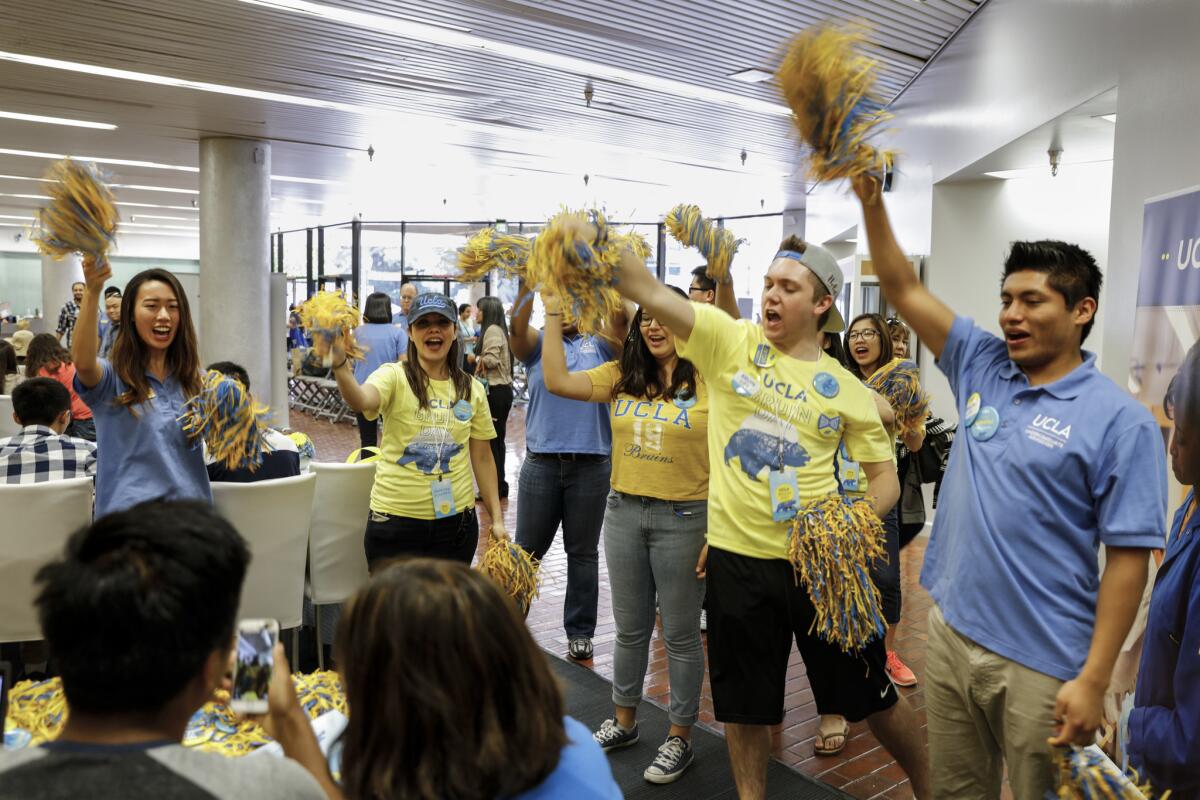California’s shifting demographics are reshaping UC student body

Armando Olea represents the future of the University of California.
The incoming UCLA freshman is a top-flight student, earning a 4.2 GPA at his San Diego high school. He’s the son of Mexican immigrants and the first in his family to attend college.
And he’s one of nearly 8,000 more Californians who committed to a University of California campus this fall — a 16% increase over last year — representing the most diverse class ever. All told, 38% of the new California freshman and transfer students were underrepresented minorities — Latinos, African Americans, Pacific Islanders and American Indians, according to UC data posted this week.
Their numbers are projected to swell even more in the next two decades as the state’s population surges by nearly 10 million to 47.2 million by 2040. The state projects an increase of 200,000 college-age Californians, and nearly half of them will be Latinos, whose high school graduation rates continue to rise.
How those demographic trends will affect the nation’s premier public research university was discussed Thursday by the UC Board of Regents, who met this week at UCLA. Under a sweeping board overhaul approved in July, regents met in committees Wednesday and reconvened as a full board Thursday for presentations on the state’s demographic trends and briefings on UCLA, UC Irvine and UC Riverside.
“The changing demographics of the state of California...will significantly impact the future enrollment growth and diversity at UC,” UC President Janet Napolitano told regents.
Although the discussion was preliminary, Napolitano said that grappling with the trends today was critical because “future UC students should have access to the same opportunities and outcomes that students today possess.”
The new data underscore the demographic shift already underway.
UC Riverside nearly doubled the number of Latino freshmen who committed to attend this fall over last year and led all campuses in new California freshman and transfer students, adding 1,300.
UCLA made strides in boosting the number of African American students, posting the highest share among all campuses — 6.9% of the 7,658 California freshman and transfer students who accepted an admission offer. Underrepresented minorities made up 35.6% of California freshman and transfer students at UCLA and 24.6% at UC Berkeley.
Overall, 43.6% of freshmen who were offered UC admission accepted.
The final enrollment numbers are likely to fluctuate slightly, since some students who register and pay a deposit may ultimately decide to withdraw their acceptance.
Napolitano told the regents that UC was well on track to surpass what she called “an aggressive and audacious goal” to increase the number of California students by 5,000 this year — and another 5,000 over the next two years — as pledged in a budget deal with Gov. Jerry Brown and the Legislature.
But James Chalfant, UC Academic Senate chairman, said that out-of-state and international students provided invaluable dollars — $800 million in supplemental tuition last year — along with talents that enrich the educational experiences of California students.
“Our commitment to access and affordability is unparalleled, but it is hollow without our third goal: quality,” he told the regents. “If we reduce nonresident tuition revenues without an alternative revenue source in mind, just what kind of university will we be providing access to?”
How UCLA is boosting campus diversity, despite the ban on affirmative action »
Indeed, officials from UCLA, UC Irvine and UC Riverside all said Thursday that financial uncertainties presented some of their biggest challenges. Six years of tuition freezes, political pressures to limit out-of-state and international students in favor of more Californians, pressing building repairs, labor demands and a far smaller share of state dollars than before have pressed officials to look for new sources of dollars.
UC Riverside presented plans for a new $300-million fundraising campaign but officials noted that their alumni are relatively young and low-income. UCLA, meanwhile, gave an update on its five-year plan to raise $4.2 billion by the university’s centennial anniversary in 2019. So far, the campus has raised $2.7 billion in cash and pledges.
The UC campuses now raise about $2 billion annually from more than 300,000 donors.
Meanwhile, UC’s debt has doubled to $17.2 billion since the 2008 recession.
On Wednesday, regents also discussed progress in seeking ways to lower the cost of an undergraduate education and accommodate more students. They include a three-year degree option with reduced requirements for upper-division courses, more online offerings for the most popular courses and incentives to take summer classes.
Campuses are aiming to enroll 5% of students in the three-year degree tracks by next summer.
Academic committee members also discussed improving access to UC for transfer students. A new program maps out specific coursework for 21 majors to help community college students make a smooth transition to a UC campus. California resident transfer students committing to UC this fall increased to a record high of nearly 17,000 students.
Several regents raised questions about how to enhance access from all of the state’s 113 community colleges — not just campuses with high transfer rates, such as Santa Monica and Pasadena.
Eloy Ortiz Oakley, a regent and the chancellor of California Community Colleges, suggested forming a committee with UC and community college officials to work on the issue, saying a similar move with Cal State University had proven successful.
An outspoken advocate of diversity, Oakley also said the new data on student commitments to UC were promising.
“We are just beginning to scratch the surface on putting a focus on diversifying our campuses,” he said in an interview. “There’s a lot of work we need to do still, but we’re at least moving in the right direction and having the right conversations.”
Olea, the new freshman who moved into his dorm this week, said UCLA has shown the way in supporting Latino students like himself. The school invited Olea to attend a freshman summer session to help him adjust to the rigorous standards, and he took advantage of peer mentoring and other academic support.
He wants to earn a doctorate in international development studies, and said such programs will help him get there.
“They introduced me to the college environment and eased the transition so that I’ll be ready in the fall,”’ he said. “That’s the beauty of UC.”
Twitter: @teresawatanabe
ALSO
These magnets have become some of L.A.’s highest-scoring public schools
UPDATES:
Sept. 15, 7 p.m.: This article was updated with additional details.
6:05 p.m.: This article was updated with additional details.
This article was originally published at 3:00 a.m, Sept. 13.
More to Read
Sign up for Essential California
The most important California stories and recommendations in your inbox every morning.
You may occasionally receive promotional content from the Los Angeles Times.











